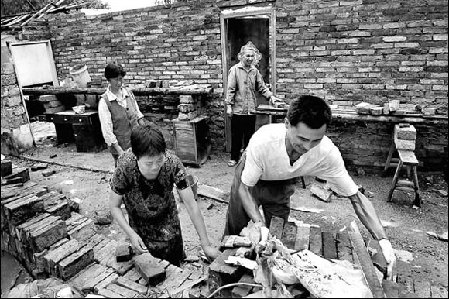
Lu Honggen (right) helps a neighbor to build her new home in the town of Guankou, Dujiangyan, an area hard hit by the quake. [Photo: Xinhua]
He Ping, a taxi driver in Chengdu, the Sichuan capital, said he was surprised to find Dujiangyan so tidy, when he drove a relief worker here yesterday morning.
"I came to Dujiangyan several times immediately after the earthquake, and many parts of the city were covered in the rubble of collapsed buildings. Now much of that has gone," he said.
Liu Gang, an official with the Dujiangyan municipal government, said workers began clearing away the rubble and dismantling dangerous buildings earlier this month, as part of the reconstruction project.
More than 500 construction experts are currently appraising all the city's buildings, and any that are considered dangerous will be pulled down and be replaced with new ones, he said.
Buildings considered inhabitable or fit for people to work in will be reinforced before being reoccupied, he said.
A new Dujiangyan will rise within three years, he said.
As most of the dangerous buildings, which number more than 100, are located in the downtown area, they will be demolished using excavators rather than explosives, he said.
Dujiangyan, which borders Wenchuan, was badly hit by the earthquake.
Sixty-five cultural relics under state protection and 119 under provincial protection in Sichuan were severely damaged.
The State Administration of Cultural Heritage said the Erwang Temple and Mount Qingcheng in Dujiangyan were among the worst hit.
The 2,000-year-old Erwang Temple, which translates as "Temple of Two Kings", was razed.
At Mount Qingcheng, the birthplace of Taoism, China's only indigenous religion, several ancient buildings are in danger of collapsing.